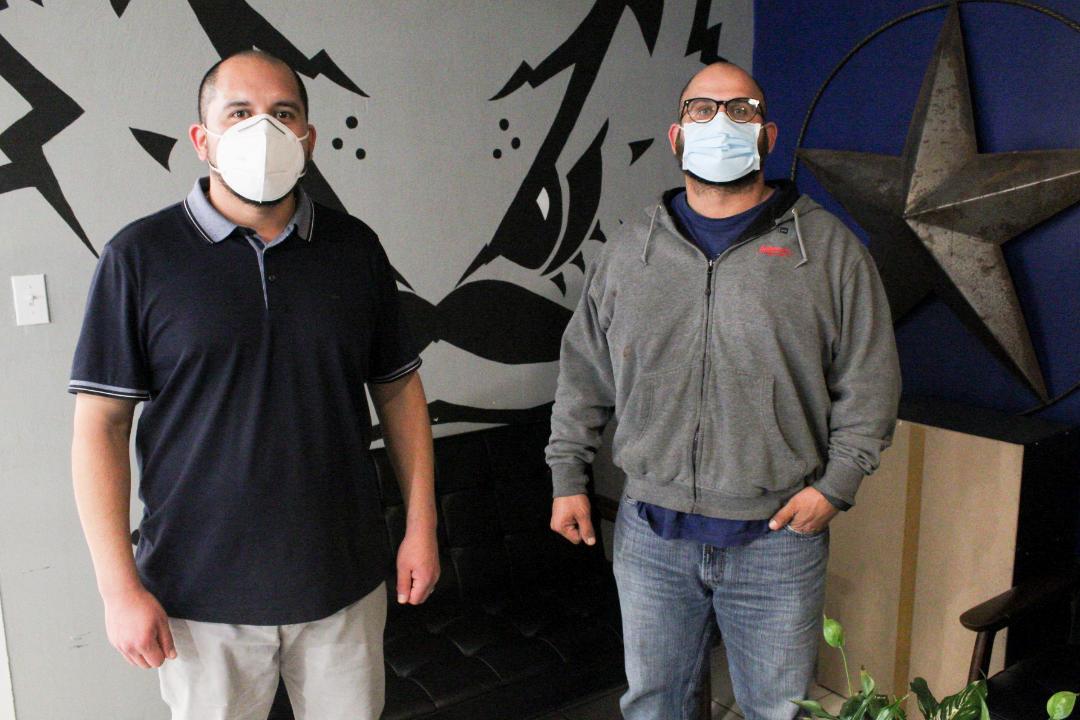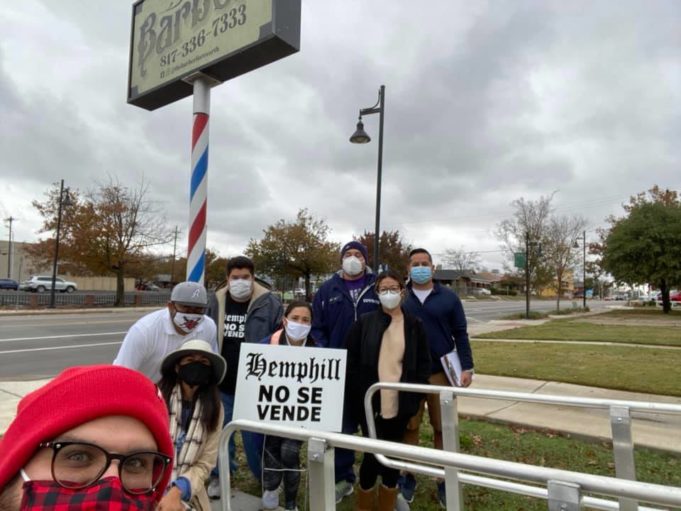Rudy Avitia swept locks of hair off the floor of his barbershop as he recounted his recent experience with Near Southside developers. After managing a successful barbershop on West Magnolia Avenue for 10 years, a Near Southside property owner forced him out in 2016, Avitia said. The space was subsequently occupied by two now-shuttered restaurants, La Zona and Southside Rambler.
Avitia moved his business south to the northeast corner of the intersection of Hemphill and West Berry streets. The move brought him closer to the neighborhood where he grew up and the predominantly Hispanic community that lives along Hemphill Street.
When Avitia recently received a notice of proposed zoning changes for the Hemphill area, he was reminded of his experience being priced out of the Near Southside. The city’s proposal, he said, will bring corporate development that will replace locally owned businesses and mega-apartments that will price out locals.
The rezoning proposal, which will be discussed at a Fort Worth Zoning Commission meeting on Wednesday afternoon, affects the Hemphill Corridor, 313 acres of largely residential neighborhoods on either side of Hemphill Street from West Allen Avenue (to the north) to West Felix Street (to the south). The proposal sets a uniform zoning designation called “Near Southside General Urban Hemphill Neighborhood.”
Rezoning the corridor is “intended to extend the urban design principles that have been so successful in the revitalization within the Near Southside,” the documents state. The rezoning will pave the way for the “adaptive re-use” of older buildings, new commercial development, and pedestrian-oriented neighborhoods.
Rudy Avitia and brother Ricardo Avitia are pushing back. With the help of local residents and business owners, the brothers formed the grassroots group Hemphill No Se Vende (Hemphill Is Not for Sale) that organizes community meetings to discuss the zoning changes and promotes civic engagement in the city’s rezoning process. Volunteers with Hemphill No Se Vende regularly canvass homes and businesses around Hemphill Street to raise awareness of the zoning proposal.

Edward Brown
“They are saying these changes are for us, but I believe it’s to [enrich] the developers,” Rudy said. “We don’t need it to look the same as the Near Southside. Why would we want it to look the same if we are not the same? This area has been predominantly Hispanic for generations. If [developers] come, we will never be able to generate wealth by owning property.”
In the United States, wealth is closely tied to the ability to own land and property. A 2019 survey by the Federal Reserve found that white families average $983,400 in wealth while Hispanic families average $165,500 in accrued assets. The families who have called the Hemphill area home for three generations are just now paying off mortgages that will allow grandparents to pass down an inheritance to better the lives of their children and grandchildren, Ricardo said.
Ricardo and Rudy said the city did not properly notify Hemphill residents of the proposed changes, although a city spokesperson said signs, emails, and meetings over the past two months were used to alert residents about the city plans. The zoning proposal should not be pushed through during a pandemic, Ricardo said.
Residents along Hemphill Street saw part of the fruits of what has been a 20-year effort to modernize and develop the area. That effort has been largely led by the Hemphill Corridor Task Force. Formed by the city more than 20 years ago, the task force involves members who own property inside the corridor or live in or near the area. The effort resulted in a complete overhaul of four miles of Hemphill Street earlier this year. The results of the so-called road diet reduced four lanes of traffic to two (one each way) while adding sidestreet parking and bike lanes. Proponents of road diets, which have reshaped much of Fort Worth’s core in recent years, say the resulting slower pace of traffic is safer for pedestrians and bicyclists and better for businesses that are more likely to be noticed by drivers who aren’t pushing 50 miles per hour.
Councilmember Ann Zadeh, whose district includes the Hemphill area, said the proposed zoning changes are being driven by volunteers who live and work in the affected area and not by outside developers. She acknowledged that the public education component of the rezoning effort may have fallen short in some areas. Zadeh, who volunteered as a zoning commission appointee before being elected to city council, understands the sometimes real, sometimes perceived connection between development and displacement.
“I think there is a difference between revitalization and gentrification,” she said. “They are often are mistaken for each other. Revitalization happens when we are trying to enhance the physical, commercial, and social components of a neighborhood, and that’s done through private and public efforts. Gentrification is when higher-income households come in and displace lower-income households and change the character of the neighborhood. That’s not something anyone is trying to do here, but it can be an unintended consequence. I don’t think that it is a reason to stop trying to improve an area. We need to be aware of it and acknowledge that it exists and address it through other private-public efforts that can address that problem.”
The zoning changes, which would replace the current hodgepodge of zoning designations in lieu of a more uniform mixed-use designation, would allow greater flexibility for future development while protecting homeowners from watching their lots wither beneath tall apartment buildings next door. The councilmember said potential new business owners would find the mixed-use zoning appealing, partly because the designation prohibits incompatible uses (like stockpiles of raw materials) in neighboring lots.
Current businesses and street vendors would not be pushed out by the proposals, she added.
“Yes, we welcome economic development, but we shouldn’t have to lose our properties,” Ricardo said, referring to concerns that steeply rising property taxes could force out homeowners if the properties are not bought outright by developers. “All their dreams that people in this community have worked so hard for is going to go away if this happens. People want to be here because we take care of our own. This plan doesn’t involve us.”
“The city is saying, ‘The way we thought of it is better,’ ” Ricardo continued. “This is a community that has been the most affected by this pandemic. For [the city] to try to rush this during a pandemic is a slap in the face. We are mourning right now. We don’t have time to think about the rezoning. We can’t even go to the hospital to visit” sick or dying relatives.
A spokesperson for the city development services department said notice signs were placed throughout the affected areas of Hemphill. Notices were also mailed to “everyone in the boundary of district expansion plus all properties 300 feet from the boundary.” Email notices were also sent, the spokesperson said. A total of 15 in-person and Zoom meetings have been held on the proposal since the idea first gained traction in October.
Zadeh said wording in the zoning language that includes “Near Southside” has been misconstrued as a sign that the Near Southside district is expanding or taking over Hemphill.
“Instead of starting from a blank piece of paper, the [zoning staff] realized there was a zoning category that exists that has components that would be desirable and beneficial for” the Hemphill area, Zadeh said. “The boundaries of the Near Southside are not expanding. The Near Southside will not have purview over what occurs.”
Rudy said his community will be able to thrive only when Hemphill residents are able to own property. Those efforts take decades, and he worries that an influx of development will force out working-class members of his community.
“If the city didn’t want us at our worst, they don’t deserve to develop us at our best,” he said.
Zadeh said that Fort Worth has historically allotted revitalization funds to vocal and connected residents and groups, but that system has changed. City staffers are now working in a “data-driven” fashion to determine where infrastructure improvements are prioritized, meaning underserved communities are more likely to be first in line for street repairs and other upgrades.
Members of the Hemphill Corridor Task Force did not respond to requests for an interview. The Wednesday Zoning Commission meeting will be held 1 p.m. at City Hall (200 Texas St.). The meeting can be viewed online at Fortworthtexas.gov/departments/communications/fwtv. A city official said the earliest the proposal could go to city council is Tuesday, January 12, but a delay in the vote now looks likely.
“The desire to engage and to have everyone at the table has been our desire from the beginning,” Zadeh said. “Now that people are speaking up, we absolutely want everyone to hear the information, express concerns, and have their concerns addressed. I would like to pause, slow down, and allow for further engagement to occur.”












